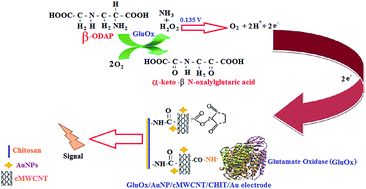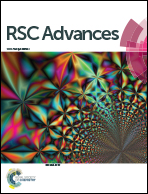Construction and application of β-(3-N-oxalyl-l-2,3-diaminopropanoic acid) biosensor based on carboxylated multiwalled carbon nanotubes/gold nanoparticles/chitosan/Au electrode
Abstract
We describe the construction of a new enzyme electrode (glutamate oxidase/carboxylated multiwalled carbon nanotubes/gold nanoparticles/chitosan/gold electrode: GluOx/cMWCNT/AuNPs/CHIT/Au) and its application for the amperometric determination of β-ODAP (3-N-oxalyl-L-2,3-diaminopropanoic acid) in Lathyrus seeds. The enzyme electrode was characterized by cyclic voltammetry (CV), electrochemical impedance spectroscopy (EIS), scanning electron microscopy (SEM) and Fourier transform infrared spectroscopy (FTIR). The biosensor showed an optimum response within 2 s at pH 7.5 and 35 °C when operated at 0.135 V. A good linear relationship was observed between the biosensor response, i.e. the current (mA), and L-glutamate (Glu) concentration in the range of 2–550 μM. The biosensor had a detection limit of 2.32 μM with a high sensitivity of 486.31 μA cm−2 μM−1. The biosensor measured β-ODAP in a glutamate-free Lathyrus seed extract. The results for ODAP efficiently correlated (r = 0.9969) with those by the standard colorimetric method. The enzyme electrode lost only 35% of its initial activity after its 70 regular uses over a period of 90 days.


 Please wait while we load your content...
Please wait while we load your content...